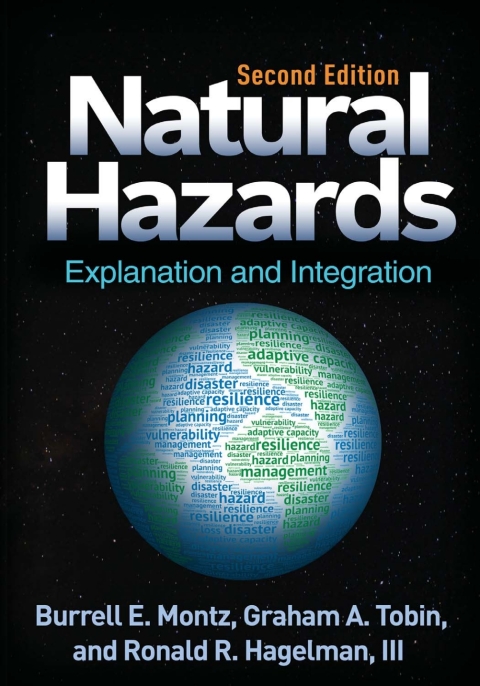Description
Efnisyfirlit
- Half Title Page
- Title Page
- Copyright
- Preface
- Acknowledgments
- Contents
- 1. Natural Hazards and Disasters: When Potential Becomes Reality
- Natural Disasters: A Normal State of Affairs
- Definitions: Natural Hazards and Disasters
- The Components of Natural Hazards: An Evolution
- Physical Perspectives
- Human Dimensions
- Structural Constraints and Societal Controls
- A Time–Space Context for Hazard Classification
- Significance of Hazard Losses
- Deaths
- Temporal Trends
- Spatial Patterns
- Geophysical Typologies
- Spatial and Temporal Trends: Explanation and Integration
- Hazards: Risk and Vulnerability
- Hazards: Players and Decision Makers
- Living with Hazards
- Fatalities, Survivors, and Others
- Hazards and Health
- Physical Problems
- Mental Health Problems
- An Integrative Framework for Analyzing Hazards
- 2. Physical Dimensions of Natural Hazards
- Introduction
- The Traditional Approach
- Geophysical Processes
- Physical Mechanisms
- Magnitude
- Meteorological Events
- Hydrological Events
- Geological Events
- Chapter Summary
- 3. Spatial and Temporal Characteristics of Natural Hazards
- Introduction
- Spatial Distribution
- Spatial Extent
- Summary
- Temporal Distribution
- Duration
- Frequency
- Seasonality
- Diurnal Factors: Differences between Day and Night
- Speed of Onset
- Theoretical Integration
- 4. Perception Studies: The Individual in Natural Hazards
- Introduction
- Underlying Hypotheses, or Easy Questions with Complex Answers
- Locational Decision Making in Hazardous Areas
- Evacuation Decision Making
- Bizarre Decision Making in Hazardous Events
- Philosophical Approaches
- Behavioral Approaches
- Preference Models
- Utility Models
- Political-Economy Approaches
- Summary
- Perception of Hazards: Contributing Factors
- Situational Factors: The Physical Environment
- Situational Factors: The Socioeconomic Environment
- Culture
- Experience
- Cognitive Factors
- Psychological Factors
- Attitudinal Factors
- Integration and Explanation
- 5. Behavioral Studies: Community Attitudes and Adjustment
- Introduction
- Choices for Communities
- Community Attitudes: A Complex of Variables
- Community Values, Norms, and Beliefs
- Size and Interorganizational Relationships
- Influences on Decision Making and Decision Makers
- Temporal Patterns in Community Response
- Immediate Postdisaster Response and Recovery
- The Important Components of Recovery
- Experience
- Leadership
- Interorganizational and Intergovernmental Coordination
- Summary
- Community Attitudes and Responses after the Cleanup
- Return to Normalcy
- Community Response Options
- Actors and Factors in Long-Term Community Response
- Maintenance of Community Attitudes and Adjustments
- Summary
- Mandated Community Adjustment
- Conclusion and Integration
- 6. Public Policy and Natural Hazards
- Introduction
- Public Problem, Public Policy
- The Goals of Policy
- Policy Implementation: Alternative Strategies
- Categories of Policy Implementation
- Regulatory Approaches
- Summary
- Programmatic Options
- Cooperative and Mandated Programs
- Constraints on Public Policy
- Physical and Technical Constraints
- Financial and Economic Constraints
- Legal, Administrative, and Ownership Constraints
- Other Constraints
- Levels of Government Involvement
- Conclusion and Integration
- The Need for Broader Planning
- Risk Assessment
- Comprehensive Planning and Policy Development
- 7. The Economic Impacts of Hazards and Disasters
- Introduction
- The Range of Considerations
- Economic Impacts of Events
- Immediate Losses from an Event
- Relief Aid Following an Event
- Long-Term Hazard-Related Impacts
- Predicting Losses
- Long-Term Impacts on the Housing Market: A Special Case
- The Economic Impacts of Policy Options and Adjustments
- Cost–Benefit Analysis
- The Indirect Economic Impacts of Adjustment Choices
- Conclusion and Integration
- 8. Risk Assessment
- Introduction
- What Is Risk?
- Hazard Risk
- Choice of Action/Survivors of Circumstance
- Outcomes: Probability and Consequence
- Uncertainty
- Risk Communication
- Risk Analysis: Different Views Yield Different Decisions
- Measures of Risk
- Perceived Risk
- Accepted and Acceptable Risks
- Availability of Information and the Role of the Media
- Summary
- The Changing Nature of Risk
- Risks from Nature and Risks from Technology
- Changing Risks by Mitigation
- Risks from Multiple Natural Hazards
- Summary
- Risk Management
- Elements of the Risk Management Process
- Conclusion and Integration
- 9. An Integrated Approach to Natural Hazards
- Theoretical and Contextual Frameworks
- Physical Characteristics of Natural Hazards
- Political-Economic Factors
- Individual and Societal Dimensions
- Social Elements
- Risk and Vulnerability
- Hazard Mitigation in Context
- The Disaster–Damage–Repair–Disaster Cycle
- Survival Amid Catastrophe
- International Initiatives
- Technological and Structural Fixes
- Data Deficiencies
- Isolated Management of Disaster Situations
- Resistant Political Forces
- Progress in Unifying Concerns
- Modeling Vulnerability and Resilience
- The Future of Hazard Reduction
- References
- Index
- About the Authors





